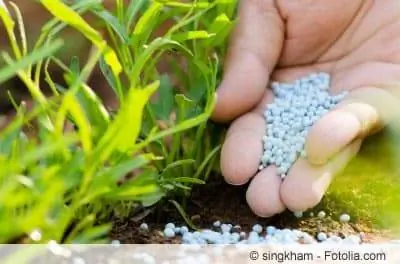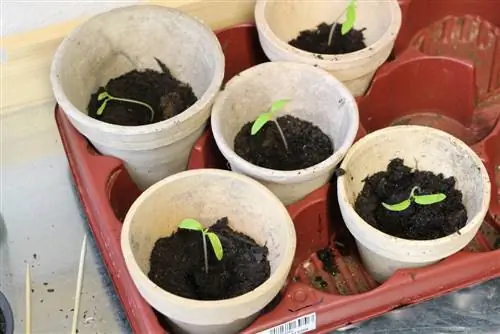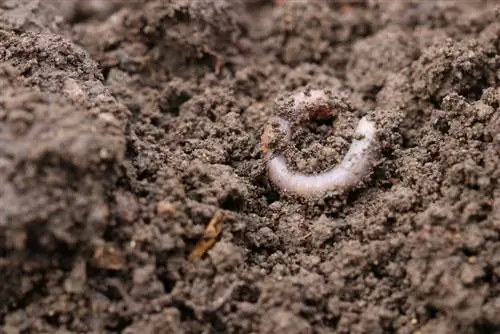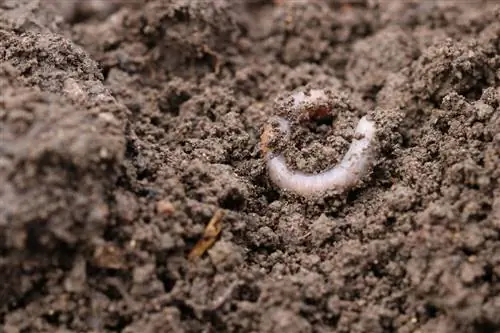- Author admin [email protected].
- Public 2023-12-17 03:39.
- Last modified 2025-01-24 12:45.
In order for plants to thrive as best as possible, they need light, warmth and sufficient water. At least as important is the quality of the soil, which can be determined in various ways.
If plants do not thrive as desired despite sufficient light and conscientious watering, this is usually due to the quality of the soil. One of the most important points here is the pH value of the soil, which has a direct effect on the nutrient absorption of the plants and is therefore even more important than the actual nutrient content. Fortunately, the pH value in question can be determined very easily and quickly yourself using an appropriate analysis device or a simple test set from the market. In addition to the pure pH value, there are of course other values that deserve attention, and a proper soil analysis laboratory may have to be commissioned to determine them.
How is the pH value determined?
If the pH value of the soil needs to be determined, a special laboratory can be commissioned to do this. However, it would be more cost-effective to simply measure the value yourself using an appropriate measuring device or analysis set. The advantages of the measuring devices are, on the one hand, their comfortable operation. On the other hand, they can be used again and again. On the other hand, the analysis sets are usually significantly cheaper to purchase. This is especially true with regard to high-quality analysis devices that can precisely analyze other quality characteristics of the soil beyond the pH value.
Which land values should definitely be determined?
In addition to the pH value, which should be between 6 and 7, one of the things that needs to be determined is the nitrate content, which must under no circumstances be too high. Of course, the main nutrients also deserve special attention. The most important of these include phosphorus, potassium and magnesium as well as the trace elements manganese, iron, chlorine, zinc, copper, boron as well as sulfur and molybdenum. Another criterion that needs to be taken into account is the soil weight or soil composition made up of sand, loam, clay, humus and other types of soil.
What are the advantages of professional analysis by a laboratory?
Although the analysis devices and analysis sets mentioned are of invaluable use, there are arguments that clearly speak in favor of professional analysis by a laboratory. The first argument is that absolutely accurate analysis values can only be achieved with the help of a laboratory. In addition, a laboratory can also determine those analysis values that cannot be determined with commercially available analysis devices or analysis sets. Particular mention should be made of any toxic substances in the soil, such as residues of lubricating oil, gasoline, kerosene or tar and the like, which would pose a danger to one's own he alth that should not be underestimated, at the latest in the case of horticulture. For this very reason, it is more than advisable to commission a laboratory for soil analysis before purchasing the property. Another advantage for laboratories is that they can use soil analysis to make well-founded recommendations regarding fertilization or other measures to improve the soil.
Tip:
If you want absolute certainty without having to incur any expenses, you should have the initial analysis carried out by an experienced laboratory and from then on carry out your own follow-up analyzes using a suitable device or set at regular intervals of two to three years.
How are soil samples taken correctly?
Before the soil analysis, there is professional sampling, which you can also take into your own hands in the case of a professional laboratory analysis. Ideally, a special drill stick should be used for this, which is usually provided by the analysis laboratory. If you want to carry out the analysis yourself, you can also use a conventional spade to take the sample if necessary. About ten samples should be taken per garden section (e.g. lawn, kitchen garden and ornamental garden). The depth of sampling depends directly on the type of garden use. In the case of heavily used kitchen gardens, the soil sample should reach a depth of 20 to 30 cm. For lawns and ornamental gardens, however, a depth of 10 to 15 cm should be sufficient. For woody plants and so-called permanent crops, a depth of a good 90 cm is recommended. After collection, the samples from the relevant garden sections are mixed together and finally analyzed according to the relevant information from the device manufacturer or set provider. Of course, the samples could also be analyzed individually instead, but this would make little sense in view of a widespread swell.
Tip:
If you want to carry out the soil analysis yourself but are afraid of the considerable costs of your own drilling stick, you can simply borrow or rent one from a nursery or garden club.
Proper handling of drill sticks
Drilling sticks are driven vertically into the ground to the desired depth using a plastic hammer. Then it is carefully pulled out again while turning slightly. If the drill core is damaged, it is recommended to take a new sample. The entire drill core can be used for soil analysis up to a drilling depth of 30 cm. For in-depth soil analysis in the case of permanent crops and woody plants, however, it is recommended to divide the core into equal parts with a maximum length of 30 cm and analyze each part separately.
Submit the soil samples to the laboratory
The soil samples are packed in bags in the quantity desired by the laboratory and labeled with all important key data. The key data in question includes the exact date and depth of sampling. The type of use of the garden section in question should also be noted. It is also advisable to provide information regarding the values to be analyzed.
Frequently asked questions
When is the best time for a soil analysis?
The initial analysis should be carried out before the actual garden planning so that the garden can be optimally divided according to the prevailing conditions and any measures can be taken to optimize the soil. The follow-up analyzes can then be carried out either in the spring before sowing or in the autumn after the harvest.
How much does a professional laboratory analysis cost?
The costs for a soil analysis depend primarily on its scope in general and the specific features for which the soil is to be examined in particular. Apart from that, prices can vary more or less from laboratory to laboratory.
How much do analyzers cost?
Simple analysis devices for determining the pH value are available for just under 10 to 20 euros. However, analytical devices that determine other values beyond the pure pH value can cost several hundred euros, so it might be cheaper to consult a professional laboratory.






